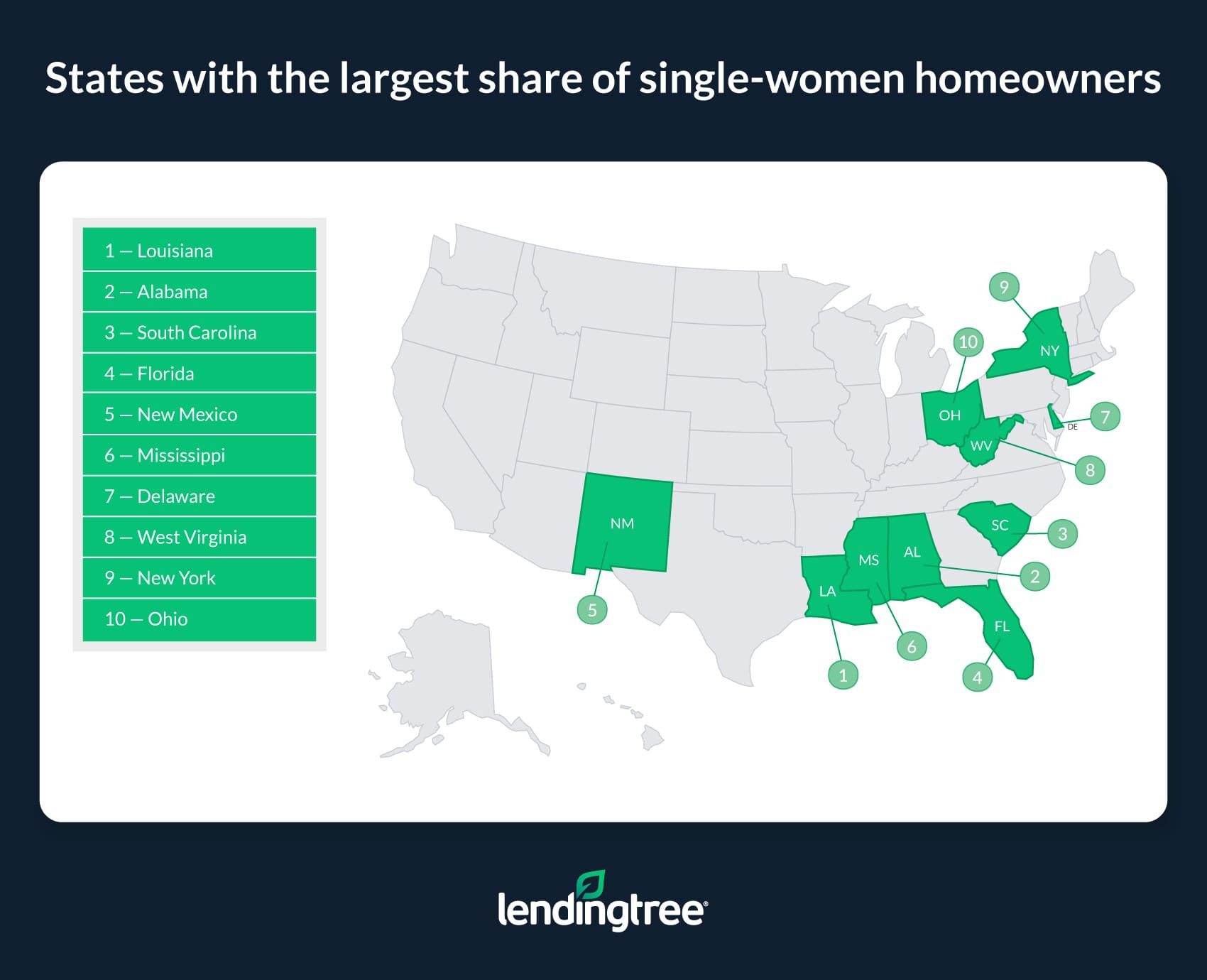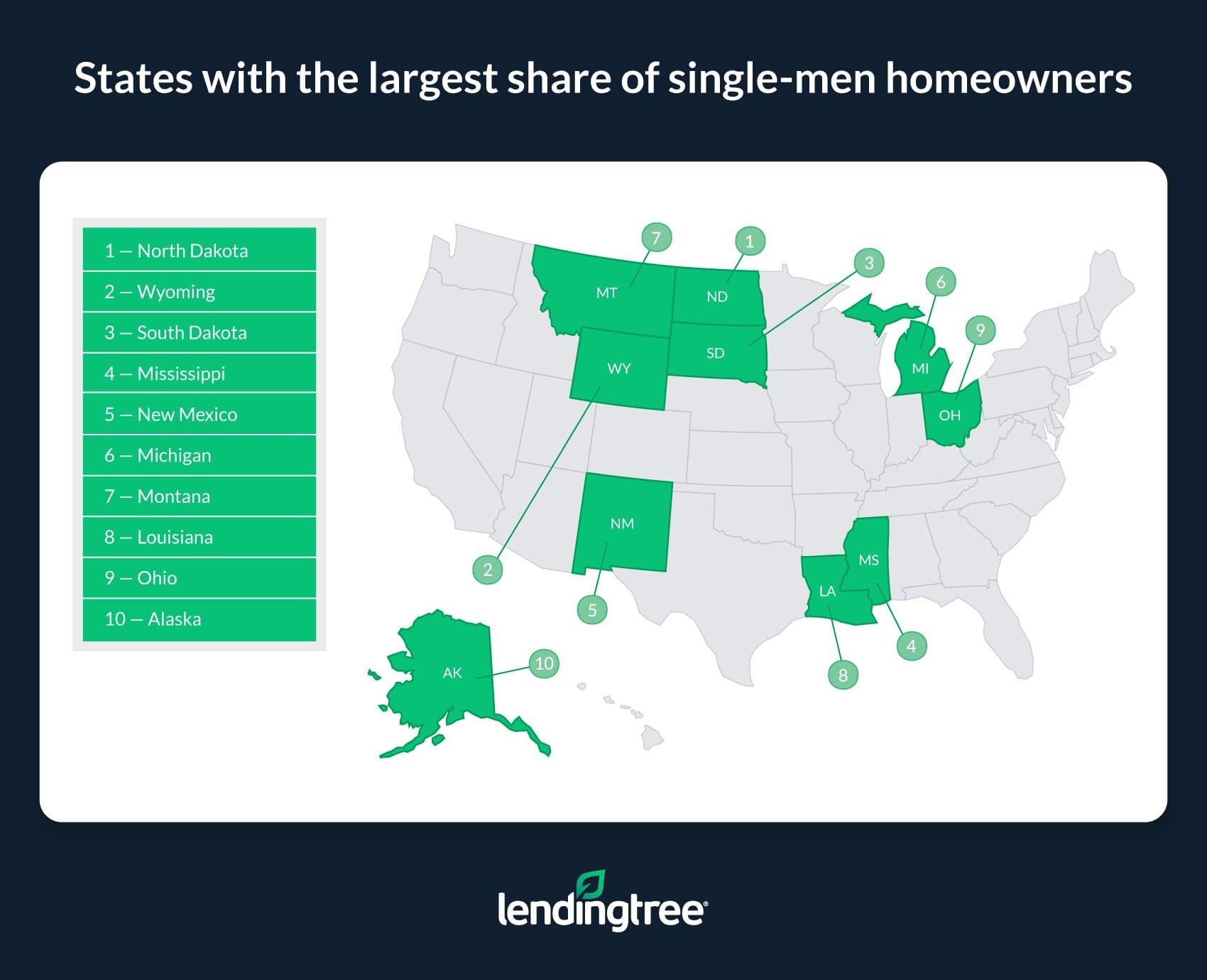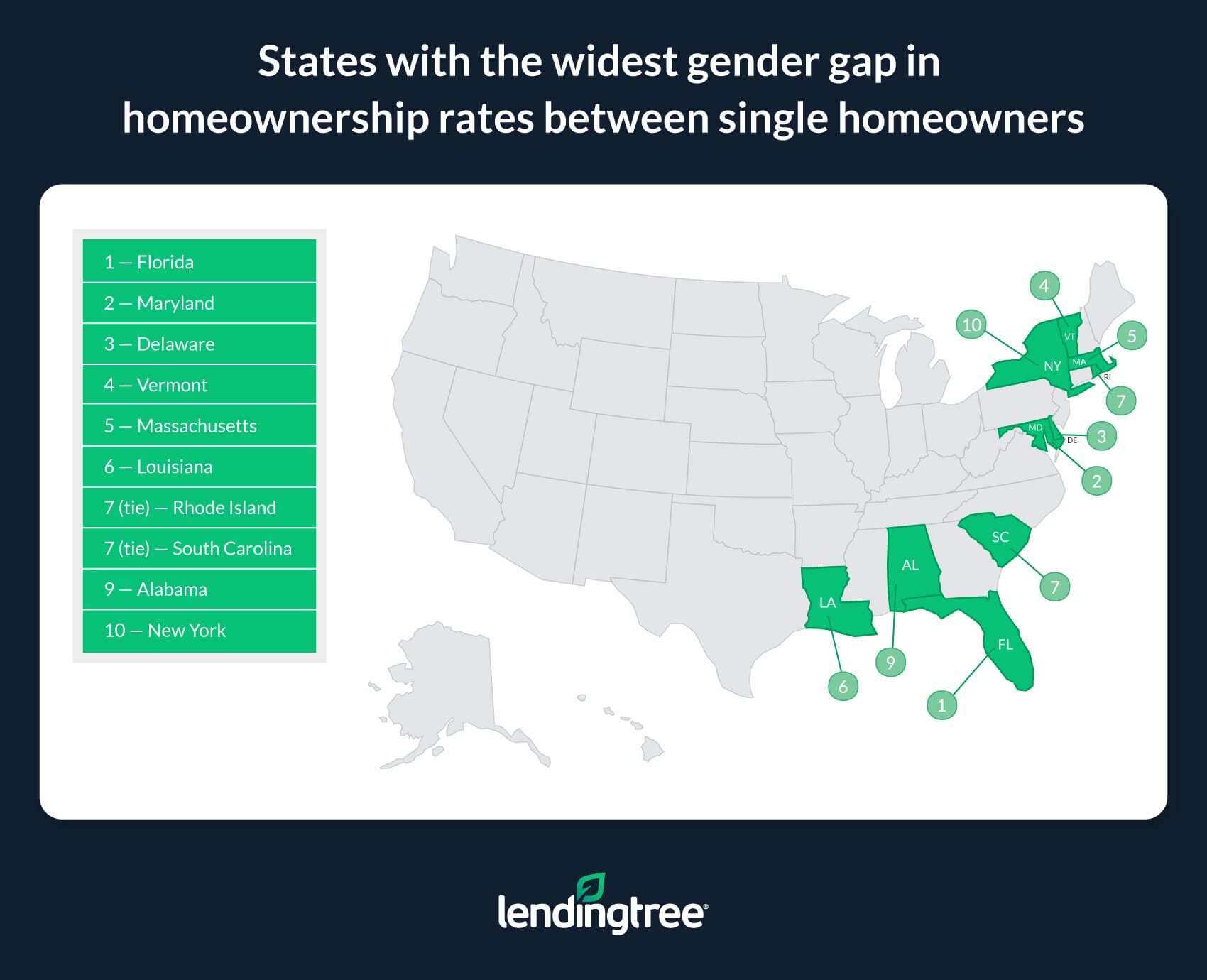Homeownership Gender Gap: Single Women Own More Homes Than Single Men
While U.S. women earn 83.1 cents for every dollar a man makes, according to the U.S. Bureau of Labor Statistics (BLS), single women own more homes than single men.
A LendingTree analysis of U.S. Census Bureau data finds that single women (women who live by themselves) are more likely than single men (men who live by themselves) to own a home in 48 of 50 states.
Read on to see which states are most popular for single-women and single-men homeowners, as well as where the homeownership gap between the genders is the largest.
On this page
Key findings
- Single women own about 2.64 million more homes than single men in the 50 states. Single women own about 10.76 million homes, while single men own about 8.12 million. Put another way, single women own an average of 12.90% of the owner-occupied homes in the 50 states, versus 10.06% among single men.
- Louisiana has the highest share of homes owned by single women. 15.16% of Louisiana owner-occupied households are owned by single women — more than 2 percentage points higher than the 50-state average.
- North Dakota and South Dakota are the only states where single men own a higher share of homes than single women. In North Dakota, single men own 12.70% of the state’s owner-occupied homes (the highest share in any state), while single women own 11.08%. In South Dakota, those figures are 11.97% and 11.29%.
- Florida has the largest gap in homeownership rates among single women and single men. The gap is 4.55% — nearly 2 percentage points higher than the national average of 2.84%.
- Wyoming has the smallest gap in homeownership rates among single women and men. Though more single women own homes than single men, the Equality State nearly lives up to its name with a homeownership gender gap of only 0.39%.
States with the largest share of single-women homeowners
No. 1: Louisiana
- Owner-occupied households: 1,202,510
- Households owned and occupied by single women: 15.16%
- Households owned and occupied by single men: 10.94%
- Gender gap between single homeowners: 4.22%
No. 2: Alabama
- Owner-occupied households: 1,379,476
- Households owned and occupied by single women: 14.98%
- Households owned and occupied by single men: 10.85%
- Gender gap between single homeowners: 4.13%
No. 3: South Carolina
- Owner-occupied households: 1,473,543
- Households owned and occupied by single women: 14.84%
- Households owned and occupied by single men: 10.65%
- Gender gap between single homeowners: 4.19%

States with the largest share of single-men homeowners
No. 1: North Dakota
- Owner-occupied households: 204,325
- Households owned and occupied by single men: 12.70%
- Households owned and occupied by single women: 11.08%
- Gender gap between single homeowners: -1.62%
No. 2: Wyoming
- Owner-occupied households: 173,177
- Households owned and occupied by single men: 12.06%
- Households owned and occupied by single women: 12.45%
- Gender gap between single homeowners: 0.39%
No. 3: South Dakota
- Owner-occupied households: 243,363
- Households owned and occupied by single men: 11.97%
- Households owned and occupied by single women: 11.29%
- Gender gap between single homeowners: -0.68%

States with the widest gender gap in homeownership rates between single homeowners
No. 1: Florida
- Owner-occupied households: 5,771,345
- Households owned and occupied by single women: 14.80%
- Households owned and occupied by single men: 10.25%
- Gender gap between single homeowners: 4.55%
No. 2: Maryland
- Owner-occupied households: 1,600,605
- Households owned and occupied by single women: 13.39%
- Households owned and occupied by single men: 8.86%
- Gender gap between single homeowners: 4.53%
No. 3: Delaware
- Owner-occupied households: 287,153
- Households owned and occupied by single women: 14.44%
- Households owned and occupied by single men: 9.94%
- Gender gap between single homeowners: 4.50%

Various factors likely contribute to higher homeownership rates among single women
Despite the data showing women generally earn less money than men, the gender gap script is flipped here. There are a few possible explanations.
For example, there’s evidence that suggests single women prioritize homeownership more than single men. There’s also evidence that single women are more willing than single men to make sacrifices to become homeowners. This could help explain why single women owe a greater proportion of homes than single men, even if they’re often less financially well off.
That said, homeownership isn’t just a young person’s game, and factors outside of earnings could contribute to them becoming homeowners. Considering that women are twice as likely to report being widowed last year than men, according to the latest U.S. Census Bureau, it’s possible — if not likely — that many women who now report being single homeowners bought that home with the spouse they outlived. This helps to explain why single-women homeowners are typically older than their single-men counterparts, even though the pay gap is wider for older Americans.
Tips for women homebuyers
While single women may be more likely to be homeowners than single men, that doesn’t mean buying a house is easy. Here are three tips to help women make their homebuying experience a bit easier to navigate.
- Shop around for a mortgage lender before you buy. Different lenders can offer the exact same borrowers different rates on their loan. Because a lower rate can help you lower your monthly payment and more easily afford a house, simply shopping around for a mortgage lender is often an important step for cost-conscious buyers to take.
- Carefully plan so you’re not overwhelmed by payments. Before you rush out to buy, be sure you can afford to become a homeowner. By sitting down and calculating what your monthly mortgage payment will look like, you can better budget for your future. If you do the math and feel like you’re going to constantly struggle to keep on top of your bills, you may want to look for something less expensive or hold off on buying for the time being.
- Know your rights. It’s illegal for a lender or seller to discriminate against you based on gender. If you think you’ve been the victim of discrimination, you can file a complaint with the U.S. Department of Housing and Urban Development (HUD) or with various local housing and human rights commissions.
Methodology
LendingTree analyzed microdata from the U.S. Census Bureau 2021 American Community Survey with one-year estimates.
To determine the gender breakdown of homeowners in each state, LendingTree focused on owner-occupied housing units whose owners were living by themselves, defining these homeowners as single women or single men.
To find the share of homeowners who were either single men or women, LendingTree divided the number of homes occupied by either men or women homeowners who lived by themselves by the total number of owner-occupied homes in a state. These percentages don’t add to 100% because there are other types of homeowners, including married couples.
To find the gender gap between women and men homeowners who live alone, LendingTree subtracted the percentage of homes owned by women who live alone in a state by the percentage of homes owned by men who live alone in that same state.
